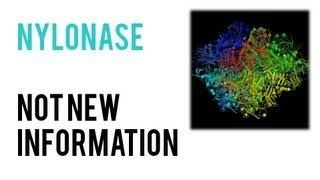Rank Strain | ||
 | ||
Similar Flavobacterium, Ideonella sakaiensis, Ideonella, London Underground mosquito, Peppered moth | ||
Nylon-eating bacteria are a strain of Flavobacterium that are capable of digesting certain byproducts of nylon 6 manufacture. This strain of Flavobacterium sp. KI72, became popularly known as nylon-eating bacteria, and the enzymes used to digest the man-made molecules became popularly known as nylonase.
Contents
Discovery
In 1975 a team of Japanese scientists discovered a strain of Flavobacterium, living in ponds containing waste water from a nylon factory, that was capable of digesting certain byproducts of nylon 6 manufacture, such as the linear dimer of 6-aminohexanoate. These substances are not known to have existed before the invention of nylon in 1935.
Further study revealed that the three enzymes the bacteria were using to digest the byproducts were significantly different from any other enzymes produced by other Flavobacterium strains (or, for that matter, any other bacteria), and not effective on any material other than the manmade nylon byproducts.
Later research
This discovery led geneticist Susumu Ohno in a paper published in April 1984 to speculate that the gene for one of the enzymes, 6-aminohexanoic acid hydrolase, had come about from the combination of a gene duplication event with a frameshift mutation. Ohno suggested that many unique new genes have evolved this way.
A 2007 paper that described a series of studies by a team led by Seiji Negoro of the University of Hyogo, Japan, suggested that in fact no frameshift mutation was involved in the evolution of the 6-aminohexanoic acid hydrolase. However, many other genes have been discovered which did evolve by gene duplication followed by a frameshift mutation affecting at least part of the gene.
A 1995 paper showed that scientists have also been able to induce another species of bacterium, Pseudomonas aeruginosa, to evolve the capability to break down the same nylon byproducts in a laboratory by forcing them to live in an environment with no other source of nutrients. The P. aeruginosa strain did not seem to use the same enzymes that had been utilized by the original Flavobacterium strain.
As described in a 1983 publication, other scientists were able to get the ability to generate the enzymes to transfer from the Flavobacterium strain to a strain of E. coli bacteria via a plasmid transfer.
Role in evolution teaching
There is scientific consensus that the capacity to synthesize nylonase most probably developed as a single-step mutation that survived because it improved the fitness of the bacteria possessing the mutation. More importantly: The enzyme involved has been produced by a mutation completely randomizing the original gene. Despite this, the new gene still had a novel, albeit weak, catalytic capacity. This is seen as a good example of how mutations easily can provide the raw material for evolution by natural selection.
